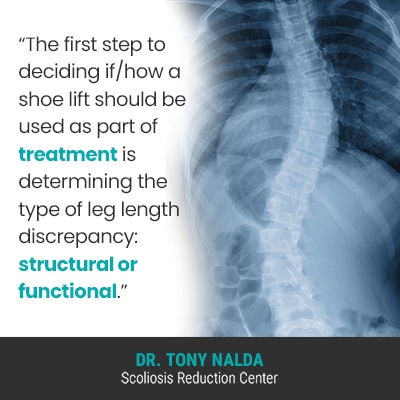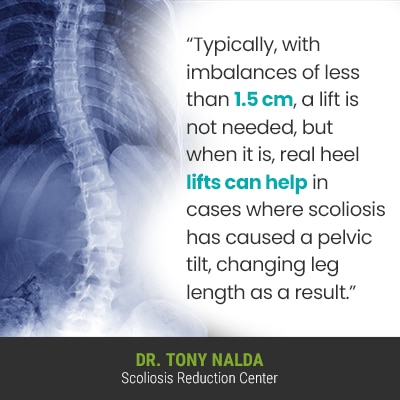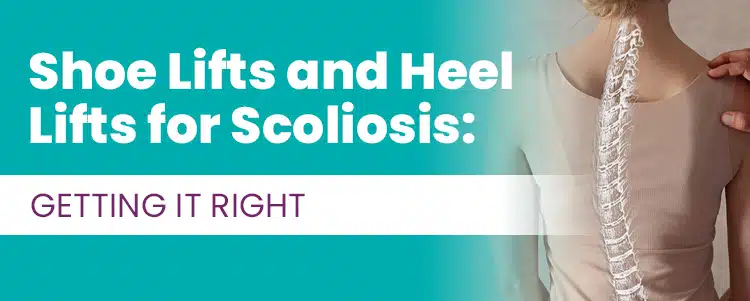When it comes to treating scoliosis, its complex nature is beyond the scope of any single discipline, instead necessitating a multifaceted and customized treatment approach. When it comes to whether or not a shoe or heel lift is used as part of scoliosis treatment, not all orthotics and heel lifts are created equal, and there are different factors to consider.
One of the main effects of scoliosis is a disruption to the body’s overall symmetry, and this is due to the condition’s uneven forces. Scoliosis is associated with a leg-length imbalance, and when appropriate, a heel lift can help reduce pain, achieve a more economical gail, and improve posture.
Before getting to the specifics of shoe lifts and heels lifts in scoliosis treatment, let’s start by defining scoliosis and how it affects the body.
Scoliosis Diagnosis and Affects
A scoliosis diagnosis means an unnatural sideways spinal curve has developed that also rotates (twists), making scoliosis a 3-dimensional spinal condition.
As the spine bends and twists unnaturally, the condition introduces a lot of uneven forces to the body, and this can disrupt its overall symmetry.
In addition, scoliosis is progressive, meaning its nature is to worsen over time, and this means that where a scoliosis is at the time of diagnosis isn’t indicative of where it will stay; only proactive treatment can work towards counteracting the condition’s progressive nature.
As scoliosis progresses, the unnatural spinal curve is increasing in size, and that means the condtion’s uneven forces are also increasing, as are their effects.
In children, it’s often uneven shoulders and hips that are the condition’s earliest telltale signs, and additional postural changes can include:
- An uneven eye line
- Uneven shoulder blades
- The development of a rib arch
- An uneven waistline
- Arms and legs that appear to hang at different lengths
Additional signs to look for can include changes to gait, balance, coordination, and clothing that suddenly seems ill-fitting.
Scoliosis Treatment and Shoe Lifts
If a leg length discrepancy is detected in a scoliosis patient, this can be for different reasons; their legs could actually be different lengths structurally, or it could be a functional difference, meaning that the discrepancy is more related to movement than an actual structural difference in height.
Changes to gait are a common aspect of scoliosis, and considering how the unnatural spinal curve pulls to the side, and the related effect of uneven hips, the side of the body with the hip that sits higher could cause the leg on the same side to be held higher, so is more of a functional discrepancy.

The first step to deciding if/how a shoe lift should be used as part of treatment is determining the type of leg length discrepancy: structural or functional.
As is the case with any symptom of scoliosis, its underlying cause has to be addressed to effectively treat it, so the first step is determining the cause of the leg asymmetry.
There are theories that the leg bones of adolescent idiopathic scoliosis patients can have different lengths, but the cause of the imbalance is unknown, making it challenging to address.
Treatment options for addressing a scoliosis-related leg length asymmetry can include adding a shoe lift or other orthotic, but before a decision has to be made, the cause has to be determined.
Structural vs Functional Leg Imbalance
Before prescribing the use of a shoe left/heel lift in scoliosis treatment, the type of imbalance has to be determined.
A true leg length discrepancy is structural, meaning there is structural abnormality causing the difference, and in these instances, a custom orthotic or heel lift can be helpful by making the body and spine more aligned, particularly during movement.
When leg length discrepancy is structural, it can be congenital (patients are born with the imbalance due to one femur bone not growing as much as the other), traumatic (trauma to one leg’s growth plate, causing it to grow slower than the other), degenerative (arthritis causes a loss of space between the hip or knee), or cancer eroding the strength and length of the long bone in one leg.
When a leg imbalance is considered functional, this means it has developed due to movement issues so can actually trick us into thinking one leg is shorter, when it’s actually more of a balance/movement issue.
Functional leg length discrepancy is caused by an asymmetry or imbalance somewhere else in the body and can be caused by a shift in the position of the pelvis, excessively tight muscles/ligaments, trunk instability, muscle imbalances, foot pronation, and scoliosis.
As scoliosis can disrupt the body’s overall symmetry and cause postural deviation, it makes sense that it could cause an imbalance in the legs as well, causing one to appear shorter than the other.
When a leg imbalance is functional, it can be addressed by proactive treatment that works towards reducing the scoliotic curve, the condition’s uneven forces, increasing core strength, improving posture and condition-effects, such as a leg imbalance; while a real heel lift can help create a more balanced type of movement to help with a functional leg imbalance, its underlying cause also has to be addressed.
Choosing the Right Shoe Lift for Scoliosis
So when a leg length discrepancy is determined to be structural, it’s time to consider a shoe lift, but not all are created equal.
Here at the Scoliosis Reduction Center®, I use a particular type of X-ray and a series of comprehensive measurements to determine if the imbalance is structural or functional.
If the imbalance is structural and involves a true leg length discrepancy, the prescription of a customized lift can result in a more economical gait, a more balanced and symmetrical posture, and reduces the uneven forces being exposed to the body; however, proactive treatment that involves a number of other forms of treatment are also being applied.
In functional cases, it’s thought that a heel lift can help slow progression by addressing an imbalance capable of causing an uneconomical gait and asymmetrical movement that can increase rates of spinal degeneration, making the spine more vulnerable to progression.
Addressing an imbalance will also help with pain being caused by the uneven wear and tear on the area of the body that’s being used asymmetrically.

Typically, with imbalances of less than 1.5 cms, a lift is not needed, but when it is, real heel lifts can help in cases where scoliosis has caused a pelvic tilt, changing leg length as a result.
The idea is that by altering the heel height, a custom orthotic or heel lift can correct a leg imbalance, and imbalances can increase the rate of scoliosis progression, in some cases, as it contributes to more uneven forces and wear and tear on the spine.
The general consensus is that orthotics, heel lifts, and inserts can help improve posture in people with skeletal abnormalities, and when they are prescribed for people with scoliosis, this is to help with pain, address imbalances, and prevent progression.
Orthotics can effectively help reduce scoliosis-related hip and back pain.
Some research suggests that adolescent scoliosis patients experienced significant curvature reductions after wearing customized shoe lifts, while other studies show that heel lifts are limited in their ability to reduce a scoliotic curve on a structural level; clearly, more research needs to be done on the subject.
Conclusion
When it comes to shoe lifts and heel lifts for scoliosis, getting it right involves first determining whether or not a leg imbalance is structural or functional.
Shoe lifts can help address a functional difference in leg length by improving a patient’s gait, making it more symmetrical, so the body is not being exposed to more uneven forces, and this is thought to help reduce a patient’s progressive rate.
When leg length discrepancy is structural, this means there is an actual difference in the leg length with one being noticeably longer than the other; a shoe lift can help as a facet of treatment by, once again, addressing one of the body’s imbalances that can increase rates of spinal degeneration.
Through the use of a specialized X-ray and a series of compressive measurements, I determined whether a true leg length is present, then prescribe the use of a customized shoe lift to help treat the discrepancy; however, the underlying cause of the imbalance, the structural nature of the scoliosis itself, has to be the focus of treatment.
In addition, X-rays also need to be performed while the patient is wearing the lift to fully monitor its effect on the spine.
Using a shoe lift alone to address a scoliosis-related leg length discrepancy is only addressing the imbalance as a symptom of scoliosis, unless its underlying structural cause is being addressed, and here at the Center, that involves condition-specific chiropractic care that works towards realigning the spine, physical therapy to increase core strength and improve posture, corrective bracing, and rehabilitation.
Not all shoe and heel lifts are created equal and have to be fully customized and bespoke to its wearer; the specifics of a patient’s condition have to be addressed, and in addition, some scoliotic curve patterns can be exacerbated by the use of a shoe lift, so just as the complex nature of scoliosis necessitates the experienced of a scoliosis specialist, shoe lifts, as part of treatment, should also be prescribed by a specialist.




